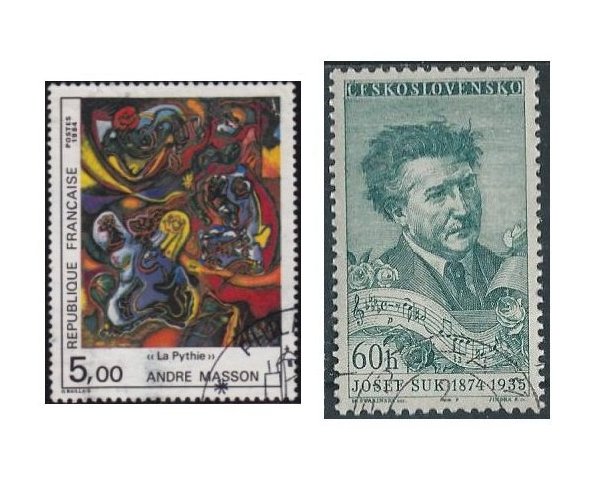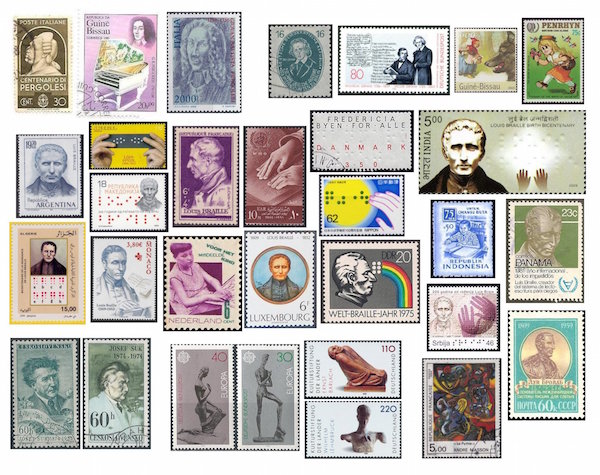The Arts on the Stamps of the World — January 4
Editor’s Note: As a lover a classical music and a stamp collector, Doug Briscoe began some years ago to concentrate on collecting worldwide stamps of composers. Three years ago he had the notion of posting some of these images to Facebook on the composers’ birthdays. Doug found to his surprise that, given the profusion of such stamps, and by expanding to performers, to anniversaries of concert halls and opera houses, to poets whose works had been set to music, etc., he was able to create a post for almost every day of the year. Now the project widens to include all the arts, as Arts Fuse kicks off this new feature.

By Doug Briscoe
January 4 is the birthday of Giovanni Battista Pergolesi, Louis Braille, Josef Suk, Wilhelm Lehmbruck, and André Masson, as well as the birthday of the elder of the Brothers Grimm, Jacob.
Pergolesi (1710 – 16 March 1736) is living—or rather, dead—proof that the Cult of Youth is nothing new. He had earned himself a wide reputation when he died of tuberculosis at age 26, and there followed a spate of compositions by other composers that were published under Pergolesi’s name, making it difficult for future generations of musicologists to separate the genuine from the spurious. In fact, in the older editions of Grove’s Dictionary of Music and Musicians the list of works *attributed* to Pergolesi was considerably longer than the genuine ones. The most famous example, I suppose, was the case of the 6 Concerti Armonici, whose authorship was finally determined only in 1980 (they were written by a nobleman who wished to remain anonymous, Count Unico Wilhelm van Wassenaer, who was of a social class that deemed composing infra dig). Pergolesi certainly did write many fine things, most notably a Stabat Mater and a comic operatic intermezzo, “La serva padrona” (The Servant Mistress).
The tales collected by Jacob Ludwig Carl Grimm (1785 – 20 September 1863) and his brother Wilhelm Carl have inspired many subsequent works of art in various forms, including the postage stamp. Here we can see one East German stamp from 1950 that specifically pays tribute to Jacob alone, along with a West German one showing both brothers and a couple of the many other stamps celebrating the tales. Coincidentally, the earlier folk tale exponent Charles Perrault has a birthday coming up on the 12th.
Louis Braille (1809 – 6 January 1852) lost his sight as the result of an accident at the age of three. He has been honored on stamps from all corners of the globe for the universally adopted system he published in 1829. To make the point I include a plentiful sampling with issues from four continents. Braille was also an accomplished musician who was gifted enough to be appointed organist at two churches in Paris. Quite early on he adapted his system to encompass music.

Czech composer Josef Suk (1874 – 29 May 1935) married one of Antonín Dvořák’s daughters and was the grandfather of one of my favorite violinists, also named Josef Suk (1929-2011). Dvořák, noting that the teenaged Suk had a predilection to write works in minor keys, urged him to compose something sunnier, and the result was the string Serenade in E-flat, Op. 6, written when Suk was only 18. Well, he met his assignment admirably. Although he went on to write many fine scores, none has ever given me the evergreen pleasure of the beautiful Serenade.
German sculptor Wilhelm Lehmbruck (1881 – March 25, 1919) trained at Düsseldorf and began as an illustrator and painter. His experiences as a paramedic in World War I are reflected in his later works, which, to quote Wikipedia, “are marked by a sense of melancholy and an elongation of form common to Gothic architecture.” He may in that regard (elongation) have been influenced by the work of Modigliani and Brâncuşi, both of whom he knew personally. Lehmbruck suffered from severe depression and committed suicide at the age of 38. There is in Duisburg a Lehmbruck Museum, containing not only his own sculptural works but many others by such artists as Käthe Kollwitz, Jacques Lipchitz, Pablo Picasso, Salvador Dalí, and Max Ernst. Germany has issued two pairs of stamps showing Lehmbruck’s sculptures, the first in 1974, the second in 1999.
French artist André Masson (1896 – 28 October 1987) began art studies at the Académie Royale des Beaux-Arts in Brussels at the age of 11. Like Lehmbruck, he took part in World War I, but as a soldier, suffering serious injuries. He was interested in cubism, surrealism, and automatic drawing, among other movements and styles. Where Lehmbruck’s work became infected with the pessimism of the First World War, some of Masson’s pieces, less obsessively, were a reaction to the Spanish Civil War. His work was declared “degenerate” by the occupying Germans in the next war, and Masson fled, first to Martinique, then to the United States. He returned to France after the war. The French stamp, dating from 1984, shows his 1943 painting “La Pythie” (“Pythia”). Masson’s children are all involved in the arts, his daughter Lily as a painter, and his sons Luís as an actor and Diego as a conductor, composer, and percussionist.
A graduate of the University of Massachusetts with a B.A. in English, Doug Briscoe worked in Boston classical music radio, at WCRB, WGBH, and WBUR, for about 25 years, beginning in 1977. He has the curious distinction of having succeeded Robert J. Lurtsema twice, first as host of WGBH’s weekday morning classical music program in 1993, then as host of the weekend program when Robert J.’s health failed in 2000. Doug also wrote liner notes for several of the late Gunther Schuller’s GM Recordings releases as well as program notes for the Boston Classical Orchestra. For the past few years he’s been posting a Facebook “blog” of classical music on stamps of the world, which has now been expanded to encompass all the arts for The Arts Fuse.
